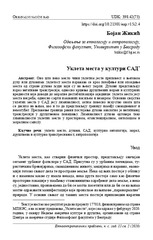Приказ основних података о документу
Haunted Places in US Culture
| dc.creator | Žikić, Bojan | |
| dc.date.accessioned | 2021-10-12T13:25:42Z | |
| dc.date.available | 2021-10-12T13:25:42Z | |
| dc.date.issued | 2020 | |
| dc.identifier.issn | 0353-1589 | |
| dc.identifier.uri | http://reff.f.bg.ac.rs/handle/123456789/3222 | |
| dc.description.abstract | What makes a place haunted is the narrative of its ghosts: the curse of the place is expressed through the hauntings of that place by the ghosts of the people who died there. Ghosts are an expression of negative transgression, that is, a violation of social norms and cultural values that leads to the moral destabilization of the community: haunted places arc places of tragedy, of deaths caused by violence and negligence. The basic features of haunted places in the US are liminality, the historical experience of what happened there, and the fact that they represent the boundary between the everyday and the impossible. The crossing of the existential boundaries by ghosts is analogous to negative transgression in social behavior. The liminality of ghosts thus corresponds to the liminality of haunted places in spatial, existential, ontological and moral terms. They appear as a kind of propaedeutic device in cultural communication, for the atrocities of their stories address what is good and bad according to the norms of cultural thought, and what is proper and improper in social behavior. Several different types of places are featured in this discussion: private ones, like dwelling places, as well as numerous public places, including a public library, a quarry, a public park, a village lane, a teahouse, the site of one of the best-known battles in United States history, a former correction facility, a beech etc, across the entire country: Atchison, Kansas; New Orleans, Fort Leavenworth and plantations in Louisiana; Peoria, Illinois; Reelsville, Indiana; Little Bighorn, Montana; Washington DC; New York City; the San Francisco Bay area; Philadelphia, Pennsylvania; Portage County, Wisconsin; Baton Rouge, Louisiana; Forester, Michigan; Cape May, New Jersey; Tucson, Arizona; Mason, Ohio. | en |
| dc.publisher | Univerzitet u Beogradu - Filozofski fakultet - Odeljenje za etnologiju i antropologiju, Beograd | |
| dc.relation | info:eu-repo/grantAgreement/MESTD/Basic Research (BR or ON)/177018/RS// | |
| dc.rights | openAccess | |
| dc.rights.uri | https://creativecommons.org/licenses/by/4.0/ | |
| dc.source | Etnoantropološki problemi | |
| dc.subject | USA | en |
| dc.subject | spirits | en |
| dc.subject | social an cultural transgression | en |
| dc.subject | moral | en |
| dc.subject | haunted city | en |
| dc.subject | cultural ontology | en |
| dc.subject | anthropology | en |
| dc.title | Haunted Places in US Culture | en |
| dc.type | article | |
| dc.rights.license | BY | |
| dc.citation.epage | 468 | |
| dc.citation.issue | 2 | |
| dc.citation.other | 15(2): 449-468 | |
| dc.citation.rank | M24~ | |
| dc.citation.spage | 449 | |
| dc.citation.volume | 15 | |
| dc.identifier.doi | 10.21301/eap.v15i2.4 | |
| dc.identifier.fulltext | http://reff.f.bg.ac.rs/bitstream/id/1824/3219.pdf | |
| dc.identifier.wos | 000547492900004 | |
| dc.type.version | publishedVersion |

